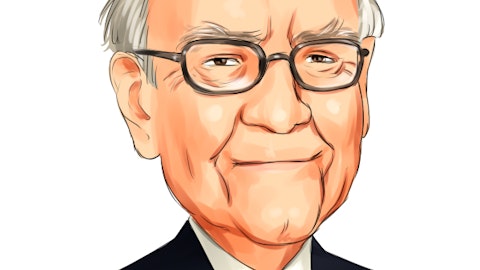Javier Rodriguez: Thanks, Dean. I think the number will be somewhere in the 30 or so closures sort of net. That would be the right number to have on the net build and closures.
Operator: Would you like to go to the next question?
Javier Rodriguez: Yes, please. Thank you, Dean.
Operator: Gary Taylor with Cowen. You may go ahead, sir.
Gary Taylor: Hey. Good evening, guys. Maybe just to follow up on that last one, that’s a 30 net for the next three quarters or that’s the full year number?
Joel Ackerman: That’s a full year number.
Gary Taylor: Okay. I just got — I want to ask, first, I’m going to commend you for producing margin growth well in excess of what the street is able to model. I think there’s a third quarter in a row where you’ve produced 30% to 50% OI growth on 6% to 8% revenue growth. So it’s really stunning cost management, productivity, all the things you guys are doing. Once we anniversary that, so maybe there’s another quarter there, but when we get it to the back half of 2024, are there still some good reasons to believe that that operating leverage can sustain at something above your long-term 3% to 7% OI guidance? What would be a couple key swing factors to be optimistic about some level of operating margin leverage continuing?
Javier Rodriguez: Yeah. So first, thank you, Gary, for those kind words. As we look forward, I think — I don’t think we’re changing our long-term OI growth number from 3% to 7%. So I’d start with that. That said, I also don’t think we’re running out of opportunities to continue to run the business well and deliver high-quality clinical care to our patients and continue to improve our bottomline and potentially our margins. We’ve done this not just on the back of cost cutting, I would highlight, right? We’ve done a lot on the revenue side that has kicked in nicely, but I think there are other opportunities as well. Continued progress on IKC would be on the list. I think capacity utilization improvements would be another important one that I point to.
I think there are other components of our cost structure, which could be productivity, could be other things non-labor related that we can continue to manage. So I don’t feel like we’re running out of ideas. That said, we’re also not ready to raise our long-term OI guidance above 3% to 7%.
Gary Taylor: Maybe last one for me. I just want to maybe understand center consolidations a little bit. When we look at average patients per center, certainly multi-multi-year high, and just in the last couple years, I think patients per center is up 9% in a couple years and your margins improved, I think, nearly 300 basis points as that’s happened. Some of that’s the consolidation. Some of that is expansion of your home programs driving that. Is this still a key lever going forward or beyond the 30 centers Javier talked about?
Javier Rodriguez: Well, I think, let me clarify, because a couple of those numbers didn’t resonate, but maybe we can clarify them here. I think the better way to think about it is, how are we doing in utilization of our centers? And pre-closing of these centers, pre- the excess mortality, we were in the mid-60%s of utilization, and right now we’re at 58%-ish utilization. And so we have more capacity available, and therefore, we’re less likely to have a need to deploy capital to build centers. And while our home has improved, it hasn’t improved that much. Our mix continues to be around 15% of our patients at home. And so hopefully that clarifies a couple of those points there.
Joel Ackerman: Yeah. And Gary, just to add one thing on to what Javier said, we can improve capacity utilization without closing any more centers. We’re just absorbing treatment growth in our existing footprint.
Gary Taylor: Adding shifts, adding machines.
Javier Rodriguez: Right.
Gary Taylor: Yeah. Got it. Okay. Thank you.
Operator: Thank you. [Operator Instructions]
Javier Rodriguez: Thanks.
Operator: Thank you. [Operator Instructions] Our next caller is A.J. Rice with UBS. You may go ahead, sir.
A.J. Rice: Thanks. Hi, everybody. First, maybe just to ask on the trajectory on IKC. I know you were forecasting for 2024 a loss of about $50 million, and I think in the first quarter you’re at $26 million. I know there’s seasonal factors and a variety of things going on, but I just wonder if you would say you’re on track? Are you running a little better or how should we put that in perspective?
Javier Rodriguez: Yeah. I would say we’re largely on track. There’s a lot of seasonality in this business, and obviously, you learn more as the year progresses, but there was nothing surprising to us in the Q1 results.
A.J. Rice: Okay. And then another thing coming off the fourth quarter, I think we had triangulated, I don’t think it was your specific guidance, but triangulated that you were sort of expecting share repurchases to be in the $1 billion to $1.5 billion range for 2024. With your comments about how the first quarter played out, do you think you’ll still get to something that maybe approximates that or should we just assume that the first quarter share purchase activity is gone and you’ll continue in the last three at the previous rate?
Javier Rodriguez: I think we still aspire to that goal. There’s obviously a timing component to it, and we’ll watch it, but we’re still aspiring to get it all done.
A.J. Rice: Okay. And just lastly to follow on the question and comments about the International acquisition, I guess it sounds like that is, in your mind, more of an opportunistic deal that came along that allows you, like you said, to leverage in certain markets and enter some new ones. Is there anything that’s happening on the International front that makes you think that the pace of activity there could step up?
Javier Rodriguez: No. I think you’ve got it in the right light, which is we are opportunistic and we’re always looking for a transaction that meets the criteria that we’ve outlined, and if we don’t find it, we don’t execute, and if we find it, we do. And so there’s no urgency or rush, but rather just doing business with discipline and according to our plan.
A.J. Rice: Okay. Great. Thanks a lot.
Javier Rodriguez: Thank you.
Operator: And our next caller is Lisa Clive with Bernstein. You may go ahead.
Lisa Clive: Hi. A few questions for me. On the utilization figures that you mentioned, that’s just looking at your in-center population, right? I’m just trying to think about how to layer in home patients on top of that, assuming that population continues to grow faster than your in-center patients, whether essentially, that improves the number of patients per clinic, but then in terms of utilization, you just think of the in-center? And then second question, could you tell us what percentage of your patients are on Mercera today? Just trying to understand how much more costs you could potentially squeeze out from that transition? And then lastly, do you have any preliminary thoughts, comments on online hemodiafiltration? I assume in your European centers, you use that technology. It obviously remains to be seen how quickly FMC can launch those machines and ramp up the scale to be able to sell them in the U.S., but just would love your thoughts on that?
Javier Rodriguez: Sure. Let me take them in order and if I miss anything, please remind me. On utilization, that number is the chronic center utilization and the way to think about a home is, of course, it can add patients much easier and with much lower capital deployment. And so you’ve got it right that that utilization that we gave is in-center. As it relates to Mercera, pretty much the vast majority, if not all, are now on Mercera, and so that’s played out. And then on hemodiafiltration, I think, it’ll be interesting to see how that plays out in the United States, because it’s — as you know, it’s allowed in many different countries and the numbers that we have are really all over the place, meaning in some countries, the vast majority of patients get it, while in others, it’s a tiny percentage of the patients that get it.
And so while there’s one or two studies that say that it could be better, because it gets the mid-molecules through, there’s a lot of holes that you can poke in those studies and so we’ll have to see how that plays out. And then, of course, the FDA approved the machine, but we don’t have any reimbursement guidance. So at the end of it, you’ll have to incorporate, A, what the doctor wants, what the patient wants, because it might take more time to do that treatment, and then put the economic model on top of that. So we’ve got too many variables there that are still to be defined to be able to size it in a helpful way.
Lisa Clive: Thanks for that. Very helpful.
Javier Rodriguez: Thank you, Lisa.
Operator: And at this time, I’m showing no further questions. Speakers, I’ll turn the call back over to you for any closing comments.
Javier Rodriguez: Okay. Well, thank you, Michelle, and thank you all for your questions and interest in DaVita. As we discussed on the call, we’re off to a strong start of the year, and of course, we’ll continue to work hard to stay on this trajectory. First and foremost, we will remain vigilant in providing great clinical care for our patients. Thank you all for joining the call and be well.
Operator: And thank you. This concludes today’s conference call. You may go ahead and disconnect at this time.
Follow Davita Inc. (NYSE:DVA)
Follow Davita Inc. (NYSE:DVA)
Receive real-time insider trading and news alerts





